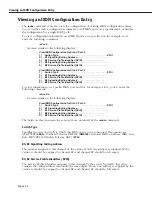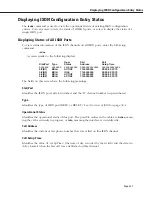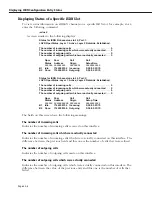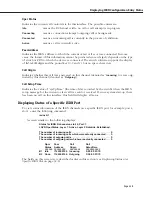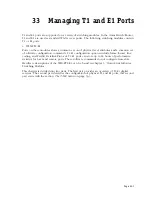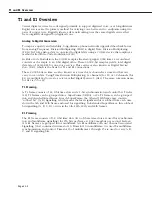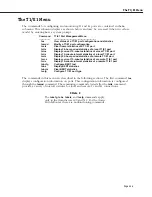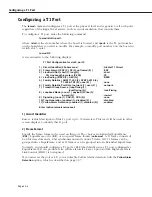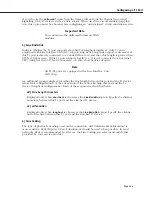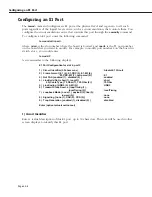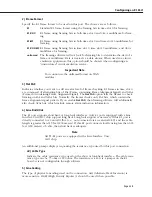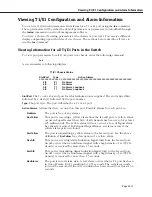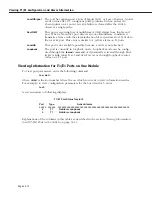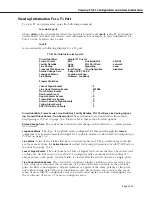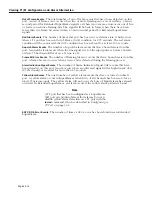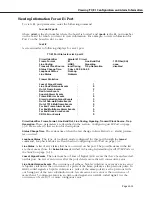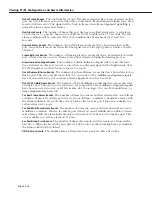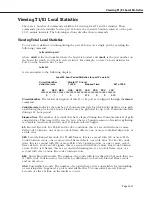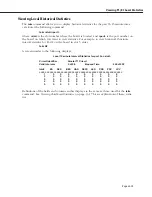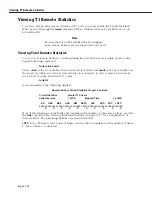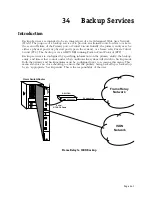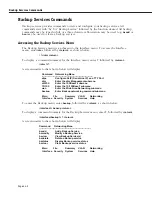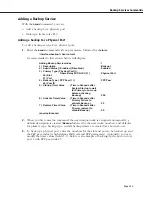
Configuring an E1 Port
Page 33-10
6) Transmit Clock Source
The source of the transmit clock. Loop timing means the receive clock (recovered from
receive data) is used as the transmit clock. Local timing indicates the local clock source
(generated from
PLL
s) is used as the transmit clock.
The transmit clock source is related to the clocking mode used in circuit emulation services.
In synchronous clock mode, both sides of the
E1
connection will use a local clock source.
However, in SRTS and adaptive clocking, the
E1
port receives the clock on one end (loop
timing) and regenerates the clock locally (local timing) on the other end. In such a case, the
E1
port receiving the clock from the network should be configured to
loop timing
and the
other end of the link should be configured to
local timing
.
7) Loopback Mode
The loopback configuration for this port. Loopback configurations describe the relation
between the device attached to an
E1
port and the framing functionality within the
E1
port.
Framing functionality assembles
E1
frames into multiframes, depending on how the port is
configured. Possible values are as follows:
none
The port is not in a loopback state. This is the typical live network state for an
E1 port.
payload
The received signal at this E1 port is looped out of the port after passing
through the port’s framing functionality. This state should only be used for
debugging purposes.
line
The received signal at this E1 port does not go through the port’s framing
functionality, and is looped straight back out the port. This state should only
be used for debugging purposes.
inward
The transmitted signal from the
inwawrd
side of this port is looped back inter-
nally. The signal passes through the E1 framing functionality before looping
back. This state should only be used for debugging purposes.
8) Signalling
The type of signaling used on this port. Only the
none
and
CAS
(Channel Associated Signal-
ling) options are applicable to a circuit emulation service port. The
CCS
(Common Signal
Channeling) option is used with external
ISDN
ports. If you select the
CAS
option, then you
are enabling Channel Associated Signalling, which is used with
E1
multiframes. In Channel
Associated Signaling, timeslot 16 in frame 0 of the multiframe is used for multiframe synchro-
nization and control. Timeslot 16 of frames 1 through 15 are used to carry A, B, C, and D
signaling bits.
9) Trap Generation
Enables all of the
SNMP
-based traps related to circuit emulation service ports.
Summary of Contents for Omni Switch/Router
Page 1: ...Part No 060166 10 Rev C March 2005 Omni Switch Router User Manual Release 4 5 www alcatel com ...
Page 4: ...page iv ...
Page 110: ...WAN Modules Page 3 40 ...
Page 156: ...UI Table Filtering Using Search and Filter Commands Page 4 46 ...
Page 164: ...Using ZMODEM Page 5 8 ...
Page 186: ...Displaying and Setting the Swap State Page 6 22 ...
Page 202: ...Creating a New File System Page 7 16 ...
Page 270: ...Displaying Secure Access Entries in the MPM Log Page 10 14 ...
Page 430: ...OmniChannel Page 15 16 ...
Page 496: ...Configuring Source Route to Transparent Bridging Page 17 48 ...
Page 542: ...Dissimilar LAN Switching Capabilities Page 18 46 ...
Page 646: ...Application Example DHCP Policies Page 20 30 ...
Page 660: ...GMAP Page 21 14 ...
Page 710: ...Viewing the Virtual Interface of Multicast VLANs Page 23 16 ...
Page 722: ...Application Example 5 Page 24 12 ...
Page 788: ...Viewing UDP Relay Statistics Page 26 24 ...
Page 872: ...The WAN Port Software Menu Page 28 46 ...
Page 960: ...Deleting a PPP Entity Page 30 22 ...
Page 978: ...Displaying Link Status Page 31 18 ...
Page 988: ...Displaying ISDN Configuration Entry Status Page 32 10 ...
Page 1024: ...Backup Services Commands Page 34 14 ...
Page 1062: ...Diagnostic Test Cable Schematics Page 36 24 ...
Page 1072: ...Configuring a Switch with an MPX Page A 10 ...
Page 1086: ...Page B 14 ...
Page 1100: ...Page I 14 Index ...

